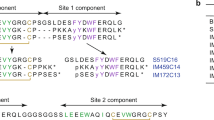Summary
We have examined some of the chemical and biological characteristics of the insulin-derived cell-associated radioactivity following incubation of isolated adipocytes with 125I-insulin (10−10 M) for one hour at 37 °C S ephadex G-50 chromatography of the cell-associated radioactivity demonstrated three peaks: peak I eluted with the void volume and consisted of large molecular weight material; peak II comigrated with 1251-insulin; and peak III consisted of small molecular weight degradation products (probably iodotyrosine). When the insulin peak (peak II) was divided into fourths, it was found that the binding and biologic activity of this material was not homogenous; thus, binding and biologic activity (relative to native insulin) fell markedly from the earliest to the latest eluting fractions of this peak. Furthermore, when the entire peak 11 material was applied to DEAE-Sephacel and eluted with a 0.01–0.2 M NaCl gradient, three distinct peaks were observed. These peaks were all 90% TCA precipitable, whereas the ability of the latter two eluting peaks to precipitate with anti-insulin antiserum was markedly reduced. When similar experiments were performed with chloroquine-treated cells, a large increase in cell-associated radioactivity was observed, and Sephadex G-50 chromatography demonstrated that this increase was entirely confined to peaks I and II. When the insulin peak (peak II) was divided into fourths, it was found that chloroquine markedly inhibited the decreased binding and biologic activity, from the earliest to the latest eluting fraction of this peak. Furthermore, when the peak II material (Sephadex G-50) from chloroquine-treated cells was chromatographed on DEAE-Sephacel, this material eluted in a single peak which was 95% TCA precipitable and 106% precipitable by anti-insulin antiserum. In conclusion, these studies demonstrate that: 1) intermediate insulin-derived products with reduced binding and biologic activity are generated in the process of cellular insulin degradation, and 2) the formation of these intermediate products is mediated by a chloroquine-sensitive pathway.
Similar content being viewed by others
References
Terris, S. & Steiner D. F., 1975. J. Biol. Chem. 250: 8389–8398.
Dial, L. K., Miyamoto, S. & Arquilla, E. R., 1974. Biochem. Biophys. Res. Commun. 74: 545–552.
Olefsky, J. M., Kobayashi, M. & Chang, H., 1979. Diabetes 28:460–471.
Assoian, R. K. & Tager, H. S., 1981. J. Biol. Chem. 256: 4042–4049.
Duckworth, W. C., Runyan, K. R., Wright, R. K., Halban, P. A. & Solomon, S. S., 1981. Endocrinology 108: 1142–1147.
Suzuki, K. & Kono, T., 1979. J. Biol. Chem. 254: 9786–9794.
Goldstein, B. J. & Livingston, J. N., 1981. Endocrinology 108:953–961.
Gliemann, J. & Sonne, O., 1978. J. Biol. Chem. 253: 7857–7863.
Baldwin, D. Jr., Prince, M., Marshall, S. & Olefsky, J. M., 1980. Proc. Natl. Acad. Sci. 77: 5975–5978.
Gorden, P., Carpentier, J-L., Freychet, P., Le Cam, A. & Orci, L., 1978. Science 200: 782–785.
Marshall, S. & Olefsky, J. M., 1979. J. Biol. Chem. 254: 10153–10160.
Hammons, G. T. & Jarett, L., 1980. Diabetes 29: 475–486.
Goldstein, B. J. & Livingston, J. N., 1981. Metabolism 30: 825–835.
Goldstein, B. J. & Livingston, J. N., 1980. Biochem. J. 186: 351–360.
Duckworth, W. C., Stenz, F. B., Heinemann, M. & Kitabchi, A. E., 1979. Proc. Natl. Acad. Sci. USA 76: 635–639.
Varandani, P. T., Shroyer, L. A. & Nafz, M. A., 1972. Proc. Natl. Acad. Sci. USA 69: 1681–1684.
Misbin, R. L., Davies, J. G., Offord, R. E., Halban, P. A. & Mehl, T. D., 1980. Diabetes 29: 730–735.
Freychet, P., Roth, J. & Neville, D. M. Jr., 1971. Biochem. Biophys. Res. Commun. 43: 400–408.
Hunter, W. M. & Greenwood, F. C., 1962. Nature (Lond) 194:495–496.
Olefsky, J. M. & Reaven, G. M., 1974. J. Clin. Endocrinol. Metab. 38: 554–560.
Rodbell, M., 1964. J. Biol. Chem. 239: 375–380.
Olefsky, J. M. & Chang, H., 1978. Diabetes 27: 946–958.
Olefsky, J. M., 1976. J. Clin. Invest. 58: 1450–1460.
Varandani, P. T. & Nafz, M. A., 1976. Diabetes 25: 173–179.
Varandani, P. T., 1978. In: Mechanisms of Oxidizing Enzymes (Singer, T. P. & Ondarya, R. N., eds.) pp. 29–43, Elsevier, Amsterdam.
Roth, R. A., 1981. Biochem. Biophys. Res. Commun. 98: 431–438.
Duckworth, W. C., 1979. Endocrinology 104: 1758–1764.
Author information
Authors and Affiliations
Rights and permissions
About this article
Cite this article
Olefsky, J.M., Saekow, M. Mechanisms of insulin degradation by isolated rat adipocytes. Mol Cell Biochem 47, 23–29 (1982). https://doi.org/10.1007/BF00241562
Received:
Issue Date:
DOI: https://doi.org/10.1007/BF00241562




